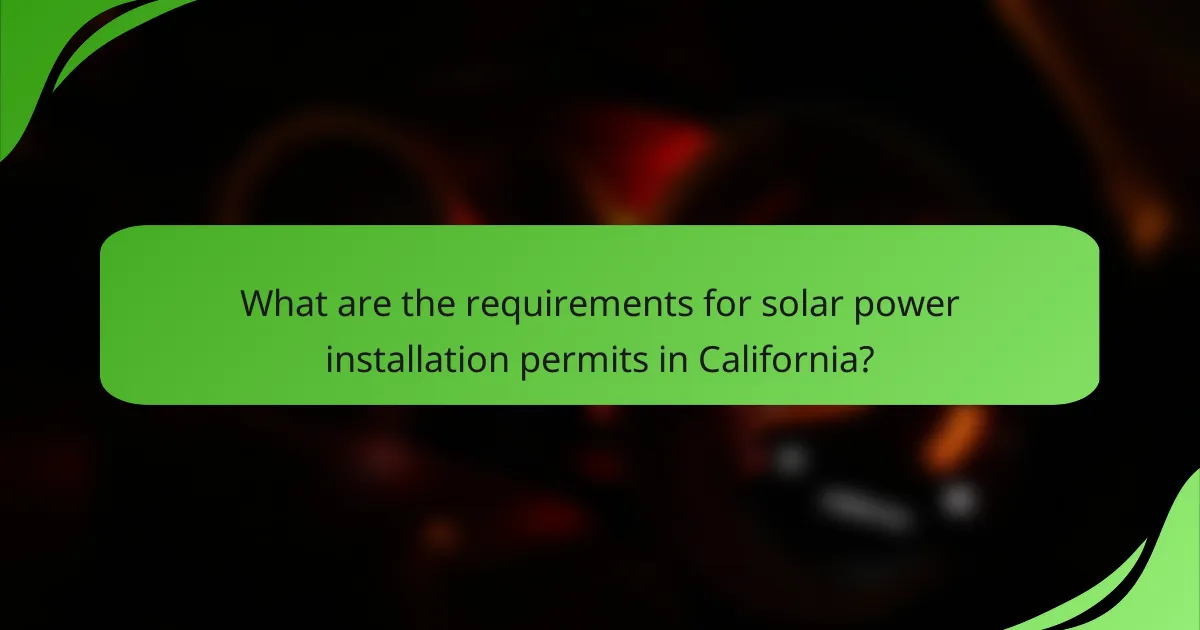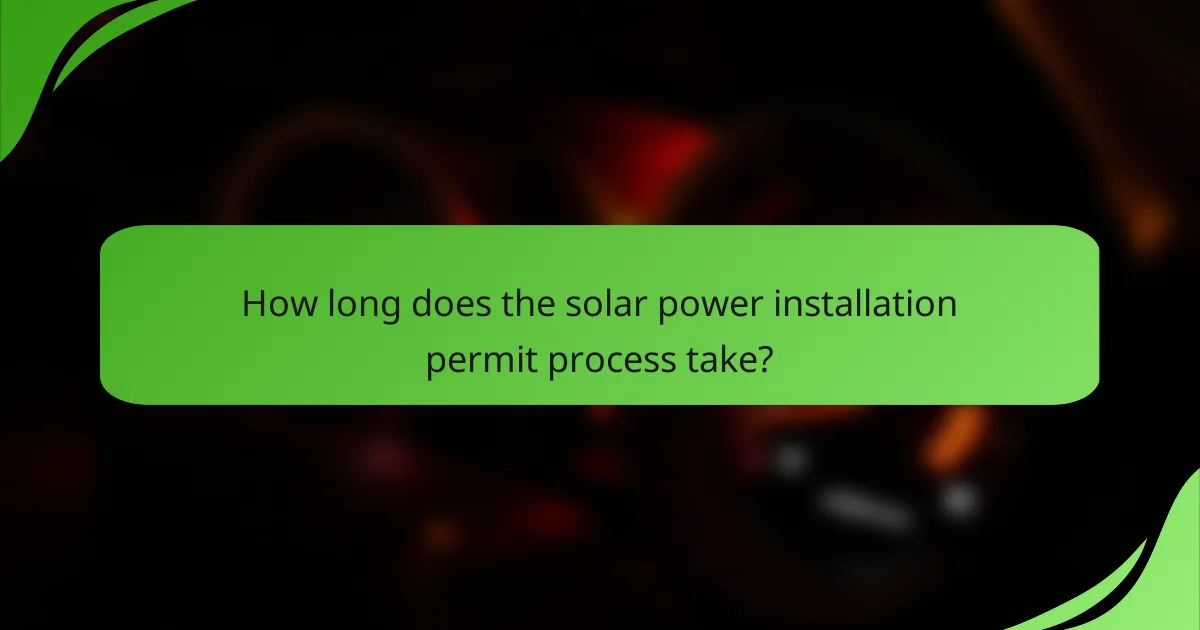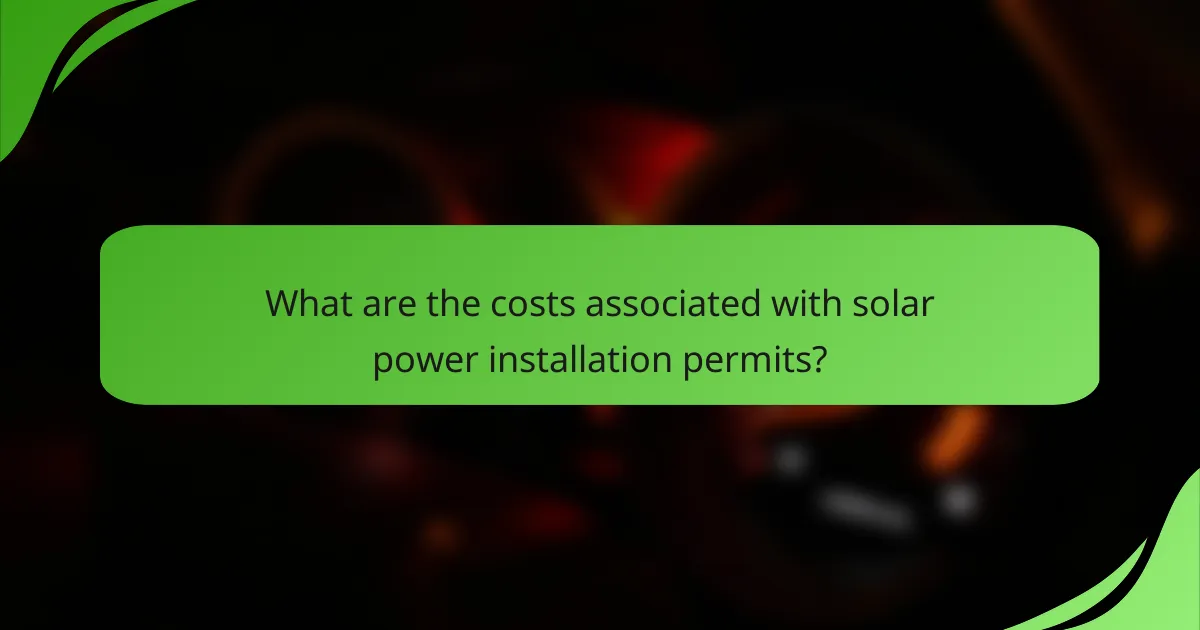Obtaining solar power installation permits in California requires compliance with various local regulations and safety standards. The process involves several key steps, including consultations with authorities, application submissions, and inspections, which can take anywhere from a few weeks to several months to complete. Familiarizing yourself with these requirements and timelines can help streamline your solar installation project.

What are the requirements for solar power installation permits in California?
In California, obtaining solar power installation permits involves meeting specific requirements that ensure compliance with local regulations and safety standards. Key elements include adherence to building codes, environmental regulations, utility agreements, zoning laws, and proper documentation during the application process.
Building codes compliance
Solar installations must comply with California’s building codes, which ensure safety and structural integrity. This includes following guidelines set by the California Building Standards Code, which covers aspects such as electrical systems, fire safety, and structural load requirements.
Before installation, it’s essential to verify that your solar system design meets these codes. Engaging a licensed contractor familiar with local codes can help streamline this process and avoid potential delays.
Environmental regulations adherence
California has strict environmental regulations that solar installations must follow, including the California Environmental Quality Act (CEQA). This act requires an assessment of potential environmental impacts, especially for larger projects or those in sensitive areas.
To comply, you may need to conduct studies on local wildlife, vegetation, and water resources. Understanding these requirements early can help in planning your installation and mitigating any environmental concerns.
Utility interconnection agreements
Before connecting your solar system to the grid, you must secure an interconnection agreement with your local utility company. This agreement outlines the terms for connecting your system, including safety standards and net metering policies.
It’s advisable to contact your utility provider early in the process to understand their specific requirements and timelines, as these can vary significantly between companies.
Local zoning laws
Local zoning laws dictate where solar installations can be placed and may impose restrictions based on property type, height, and visibility. Understanding these regulations is crucial to ensure your project complies with local ordinances.
Check with your city or county planning department for zoning requirements specific to your area. This may include obtaining special permits or variances if your installation does not conform to standard zoning regulations.
Permit application documentation
The permit application for solar installations typically requires various documents, including site plans, engineering drawings, and proof of compliance with local codes. Accurate and complete documentation can significantly expedite the approval process.
Prepare a checklist of required documents and consult with your local permitting office to ensure you have everything needed. Common pitfalls include missing signatures or incomplete forms, which can delay your project significantly.

What is the process for obtaining solar power installation permits?
The process for obtaining solar power installation permits typically involves several key steps, including consultations with local authorities, submitting applications, and undergoing inspections. Understanding these steps can help streamline the approval process and ensure compliance with local regulations.
Initial consultation with local authorities
The first step in the permit process is to consult with local authorities to understand specific requirements for solar installations in your area. This may involve contacting the local building department or planning office to discuss zoning laws, building codes, and any other regulations that may apply.
During this consultation, it’s beneficial to ask about any necessary documentation and fees associated with the permit application. Gathering this information early can save time and prevent delays later in the process.
Submission of permit application
Once you have gathered the necessary information, the next step is to submit your permit application. This application typically requires detailed plans of the proposed solar installation, including system specifications and site layouts.
Be prepared to pay any associated fees at this stage, which can vary widely based on location and the size of the installation. Ensure that all required documents are complete to avoid any issues during the review process.
Review period by local government
After submission, your application will enter a review period where local government officials assess compliance with regulations and safety standards. This period can range from a few days to several weeks, depending on the complexity of the project and the workload of the reviewing agency.
During this time, officials may request additional information or modifications to your plans. Promptly addressing these requests can help expedite the review process.
Inspection scheduling
Once your application is approved, the next step involves scheduling inspections. Inspections are crucial to ensure that the installation meets all safety and building codes. Typically, you will need to arrange for at least one inspection before the installation begins and another after it is completed.
Contact your local building department to understand the inspection requirements and schedule. Being proactive in scheduling can help avoid delays in your project timeline.
Final approval and permit issuance
After successful inspections, you will receive final approval and your solar installation permit will be issued. This permit allows you to proceed with the installation of your solar power system legally.
Keep the permit on hand throughout the installation process, as it may need to be presented during inspections or to contractors. Ensure that all work complies with the terms of the permit to avoid potential fines or the need for re-inspection.

How long does the solar power installation permit process take?
The solar power installation permit process typically takes anywhere from a few weeks to several months, depending on local regulations and the complexity of the project. Understanding the timeline can help you plan your installation more effectively.
Typical timeline in California
In California, the solar permit process usually ranges from 2 to 6 weeks. This timeframe includes the submission of your application, plan review, and any necessary inspections. Larger or more complex installations may require additional time for review and approval.
Many California cities have streamlined processes that can expedite permits, especially for residential solar systems. However, it’s essential to check with your local jurisdiction for specific timelines and requirements.
Factors affecting processing time
Local regulations and workload at the permitting office can also affect processing times. During peak seasons, such as spring and summer, expect longer wait times due to increased demand for solar installations.
Expedited permit options
Many jurisdictions offer expedited permit options for solar installations, which can significantly reduce processing times. These options often require a simplified application process and may involve additional fees. Check with your local permitting office to see if expedited services are available.
Some areas have adopted streamlined permitting programs that allow for quicker approvals, especially for standard residential solar systems. Utilizing these programs can help you get your solar project underway faster.

What are the costs associated with solar power installation permits?
The costs associated with solar power installation permits can vary significantly based on location and project size. Typically, these costs include permit fees, inspection fees, and potential additional expenses related to compliance with local regulations.
Permit fees breakdown
Permit fees for solar power installations generally range from a few hundred to several thousand dollars, depending on the jurisdiction and the complexity of the project. For example, urban areas may charge higher fees due to increased administrative costs, while rural locations might have lower fees.
It’s important to check with your local government or permitting office for specific fee schedules. Some places may have a flat fee structure, while others might base fees on the system size or estimated installation cost.
Additional costs for inspections
In addition to permit fees, inspections are often required to ensure compliance with safety and building codes. Inspection costs can vary, typically ranging from $100 to $500 per visit, depending on the local rates and the number of inspections needed.
Homeowners should anticipate multiple inspections throughout the installation process, including pre-installation and final inspections. It’s advisable to budget for these costs early in the planning phase to avoid surprises later on.
